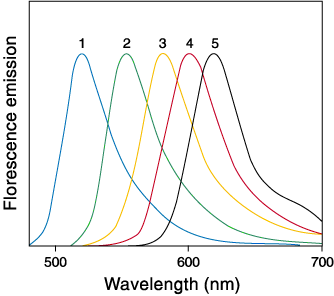|

| |
Different fluorochromes might need different excitation wavelengths. But fluorochromes
that can be excitated with the same wavelength can have different emission
wavelengths. This makes it possible to measure signals from different
fluorochromes in a flow cytometer with one laser (= one wavelength).
A fluorescence
microscope uses a high powered mercury lamp. This lamp has a large part of the
spectrum and is able to excitate more different fluorochromes. Both flow cytometer and
microscope use filters to select for the specific emission. Excitation and
emission wavelength determine the fluorochrome(s) that can be used.

Figure.1.A. Normalized fluorescence emission spectra of goat anti–mouse IgG conjugates of 1)
fluorescein, 2) rhodamine 6G, 3) tetramethylrhodamine, 4) Lissamine rhodamine B and 5) Texas Red
dyes. (figure taken
from the Handbook of fluorescent Probes and Research Chemicals from Molecular
Probes (fig.1.10))
| Probe |
Ex (nm) |
Em (nm) |
Alternative name |
| |
| Cascade Blue |
375;400 |
423 |
|
| Lucifer yellow |
425 |
528 |
|
| NBD |
466 |
539 |
|
| R-Phycoerythrin (PE) |
480;565 |
578 |
|
| PE-Cy5 conjugates |
480;565;650 |
670 |
Tri-Color, Quantum Red |
| PE-Cy7 conjugates |
480;565;743 |
767 |
|
| Red 613 |
480;565 |
613 |
PE-Texas Red |
| PerCP |
490 |
675 |
Peridinin chlorphyll protein |
| TrueRed |
490,675 |
695 |
PerCP-Cy5.5 conjugate |
| Fluorescein |
495 |
519 |
FITC |
| BODIPY-FL |
503 |
512 |
|
| Cy3 |
512;552 |
565,615 |
|
| TRITC |
547 |
572 |
TRITC |
| X-Rhodamine |
570 |
576 |
XRITC |
| Lissamine Rhodamine B |
570 |
590 |
|
| Texas Red |
589 |
615 |
Sulfonyl chloride |
| Cy5 |
625-650 |
670 |
|
| Allophycocyanin (APC) |
650 |
660 |
|
| APC-Cy7 conjugates |
650;755 |
767 |
PharRed |
| Cy7 |
743 |
767 |
|
Table.1.B. Excitation (ex) and emission (em) of generally used fluorochromes
in order of their ex wavelength.
|